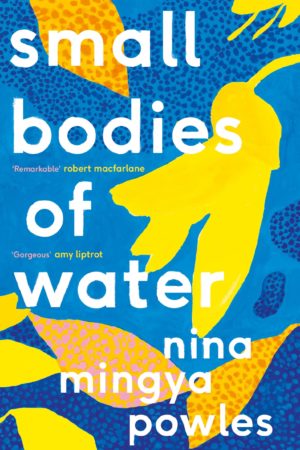Small Bodies of Water
by Nina Mingya Powles
reviewed by Alistair Murray
The essays in Nina Mingya Powles’s Small Bodies of Water range across topics and move between hemispheres, animated by objects and topics as various as orcas, ideograms, ichthyology, tofu, and kōwhai trees. Its organizing motif, though, is water—oceans, harbors, swimming pools, and waterfalls. Small Bodies of Water won the inaugural Nan Shepherd Prize in 2019, which recognizes new voices in nature writing, and the book joins Leanne Shapton’s Swimming Studies and Ingrid Horrocks’s recent Where We Swim in using memoir to attend to the various meanings—personal, familial and ecological—that we attach to the experiences of swimming or living next to bodies of water.
The usual anxieties around climate change and ecological destruction are registered here, of course: Powles worries about a climate report on the impact of sea level rise on Borneo and cries while watching Frozen 2. She asks whether it is possible to write about nature without writing elegiacally, and tries not to become overwhelmed by “anticipatory grief.” Meanwhile other political and social realities intrude. She even wonders about unequal access to swimming lessons, noting that the public pool is a space “governed by rigid structures of gender, class, whiteness, [and] the various shapes of our bodies.”
Powles writes about bodies of water not as phenomena in themselves so much as figures for personal ambivalence, or as scenes for encountering the messiness of “existing in two places at once.” An aura of suspension hovers over the book, and Powles spends much of it scavenging for some way to “feel less adrift.” While writing of the experience of being away from home, Powles—who was born in Wellington, New Zealand, grew up in New York and Shanghai, and currently lives in London—describes a kind of incipient homesickness that would suddenly “pull me under without warning.” But the very concept of “home” has no stable referent:
Where is the place your body is anchored? Which body of water is yours? Is it that I’ve anchored myself in too many places at once, or nowhere at all? The answer lies somewhere between. Over time, springing up from the in-between space, new islands form.
Much of the book moves fluidly in this way between self and place, with each underscoring the instabilities of the other. In an essay entitled “The Safe Zone,” which describes the anxiety of living in a Wellington constantly threatened by the prospect of a devastating earthquake, Powles looks at a fault line map of the surrounding area and finds that it looks like an extension of “the human nervous system, as if the islands were made of nerves splitting off into intricate connected branches.” To swim in this place is to “swim in the deep seam between two tilted pieces of land that have been pulled apart over time.”
If a narrative arc appears across these essays, it traces a movement away from this kind of drifting itinerancy towards different forms of suspension and separation: in the closing essay, plans to visit family in Malaysia and summit Mount Kinabalu are scuppered by lockdowns and border closures. It is one of the book’s strongest (because most cogent) sections. In it, Powles reads botanical accounts of Kinabalu by naturalists and botanists held by the Linnean Society of London, an institution “established almost solely for the cataloguing and archiving of Empire,” through and alongside a capacious personal archive of colors, plants, and waterfalls. Reading her family history against the products of imperial taxonomy, Powles asks what it means to live on stolen land: “being tauiwi”—non-Māori, non-indigenous—“doesn’t mean I’m left drifting, rootless, untethered to an ancestral homeland. It means tracing the threads back to the roots of my history, my colonial history, and holding all the pieces in my hands. It means always looking for the sea.”
The risk of depending on fragments and oceanic metaphors to furnish a structure for a book is that the final product all too often substitutes associative patterns for hard thinking about the realities of belonging, historical memory, and place. From the beginning, considering the breadth of material here, there is a distinct risk that Small Bodies of Water might lack sufficient connective tissue and buckle under the weight of so many disparate parts, and that its lyric sensibility and projection of a suspended, “in-between” place might come to look like an alibi for equivocation or just plain drifting. I’m not quite convinced that the book manages to contain these risks completely. Powles tells us that she is “happier where there’s something solid to hold on to,” but the challenge here is to hold on to so many things at once.
Published on March 22, 2022

